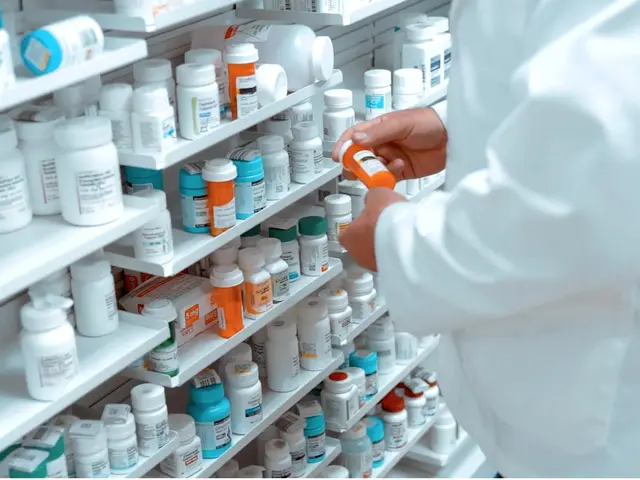You probably remember Zantac, that little pill everyone reached for whenever heartburn reared its ugly head. For years, it sat in pharmacies, purses, and glove compartments—a staple for people who craved tacos but not the fire that sometimes followed. Then, out of nowhere, news dropped that stopped a lot of folks in their tracks: Zantac, or ranitidine, was being yanked from shelves, not because it didn't work, but because it might not be safe. Nobody likes having their trusty go-to turn into the latest health scare. So what really happened? And what should you actually do if you once swore by Zantac for relief?
How Zantac Changed Heartburn for Nearly 40 Years
When Zantac first hit the market back in the early 1980s, it was kind of a game-changer. Before that, antacids like Tums or Maalox were the best most people could do—neutralize acid after you already felt it clawing up your throat. Zantac came along with a new approach. Instead of neutralizing acid, it tamped down your stomach’s actual production of acid. For millions struggling with persistent heartburn or ulcers, that was huge. Imagine chowing down on pizza, knowing you wouldn’t be curled up, regretting life, two hours later. That’s what Zantac promised.
The secret behind Zantac is its active ingredient—ranitidine, a drug classified as an H2 blocker. H2 blockers tell your stomach to pump out less acid, making it way easier for people to eat what they loved without fear. Zantac became a household name, recommended by doctors and loved by anyone who got those nighttime acid disruptions. By the mid-2000s, Zantac was available over the counter. It sold well over 15 million prescriptions in a single year, reaching its hands into just about every medicine cabinet in America. But like every overnight sensation, it eventually faced trouble that nobody saw coming.
The Recall: What Went Wrong with Ranitidine?
Zantac’s downfall started with a discovery that seems ripped from a medical detective show. In 2019, an online pharmacy called Valisure reported that ranitidine could break down and form an impurity known as NDMA, or N-Nitrosodimethylamine, a substance classified as a probable human carcinogen. Basically, in certain conditions, ranitidine could create something you really don't want in your body if you’re trying to avoid cancer. Lab tests showed that levels of NDMA in some ranitidine products were way higher than the safe limit set by the FDA.
Once this information hit the FDA’s desks, things moved quick. In early 2020, shelves started clearing. By April of that year, the FDA called for a full-blown recall of all Zantac and generic ranitidine products. It didn’t matter whether it was the prescription strength, cool-mint flavored, or the store-brand stuff you snagged on a late-night run—it was all pulled. The scariest part? The NDMA concern didn’t hinge on how the drugs were made but on how they were stored over time, especially in warm temperatures. NDMA levels could soar even while the package sat in your car or cabinet in the summer.
People wondered, "If I took Zantac for years, am I at risk?" The FDA said there’s no immediate evidence linking Zantac or ranitidine to widespread cancer, but admitted they don’t have all the answers. Plenty of lawsuits piled up from people worried about long-term exposure, and research is still catching up. Here's a quick snapshot of the recall timeline and NDMA limits—just to give you an idea how fast the news hit:
| Year/Event | What Happened | NDMA Safe Limit (per FDA) |
|---|---|---|
| 2019 | Initial Valisure report finds NDMA in ranitidine up to 3,000 ng/tablet | 96 ng/day |
| 2020 | FDA requests recall of all ranitidine products | 96 ng/day |
| 2021+ | Research investigating long-term health impact | 96 ng/day |
If that table makes you sweat, remember: much of the concern hinges on long-term, repeated exposure. Still, stopping Zantac cold turkey was the safest bet. It’s no longer on U.S. shelves as of June 2025, and similar moves happened in Canada, Europe, and Australia.
What Should You Use Instead? Navigating Heartburn Relief Post-Zantac
If Zantac played a leading role in your medicine lineup, you might feel backed into a corner now. The good news is: doctors didn’t just shrug and leave people stranded. There are plenty of other tools for managing heartburn or acid reflux, and some work even better. Here’s the lowdown on alternatives:
- Pepcid (famotidine): This is another H2 blocker, chemically different from ranitidine, so nobody’s caught it producing NDMA. It works pretty much the same way—just doesn’t have Zantac’s old baggage. Many doctors switched patients to Pepcid practically overnight.
- Proton Pump Inhibitors (PPIs): Think Prilosec (omeprazole), Nexium (esomeprazole), and Prevacid (lansoprazole). These are heavy hitters that almost stop acid production in its tracks. PPIs are usually used for more serious GERD or ulcers, and for the short term, they’re really effective.
- Classic antacids: Sometimes simple is best. Chewable tablets like Tums or Mylanta have stood the test of time. They don’t last long, but for the rare pizza binge, they do offer immediate relief.
When Zantac vanished, pharmacies rolled out signs and special shelves pointing people toward these other options. It’s a strong reminder that the FDA keeps a close watch on safety and sometimes making a switch is healthier, even if it’s annoying to start over. If you’re worried about your specific stomach issues, a chat with your doctor still beats self-diagnosing—or grabbing random bottles off the shelf. Sometimes heartburn points to bigger problems than spicy takeout, after all.
For anyone managing weekly or even daily heartburn attacks, here are a few useful tips beyond medication:
- Eat smaller meals and don’t recline right after eating—let gravity help keep your stomach acid where it belongs.
- Identify foods that trigger your symptoms. Spicy foods, chocolate, caffeine, and tomato sauce are usual suspects.
- Wear comfortable clothes around your waist—tight belts or pants can press on your stomach and trigger reflux.
- For night owls, try elevating the head of your bed about six inches. Acid can creep up more when you’re flat on your back.
- Quit smoking if you can. Nicotine weakens the muscle keeping stomach acid in check.
- If you’re overweight, shedding even five or ten pounds can make a real difference.
That said, medication still has a role, especially for those who can’t keep heartburn under control with lifestyle changes alone. Your best bet? Tailor your treatment to your specific pattern. If heartburn shows up only during stressful weeks or special occasions, antacids or just being careful with food might be enough. If it’s constant, talk with your doctor about the safest, most effective options now that Zantac is out of the game.

The Lawsuits and Science: Sorting Real Risk from Hype
The minute Zantac was recalled, lawyers jumped on TV ads telling people about possible cancer risks. It’s a natural reaction to feel nervous, especially if you’ve been taking ranitidine for months or years. So what do the numbers and studies actually say?
Since the recall, researchers have looked hard for patterns. So far, there’s no official proof that typical use of Zantac or ranitidine causes cancer in most people. The biggest studies have mostly found “no clear evidence” that taking the drug at regular doses for a few years increases your risk. Still, the NDMA alarms matter, because high doses of NDMA in animal studies did cause cancer, especially when given for long stretches.
Here’s what’s confirmed so far:
- NDMA is found in loads of things, including grilled meats, beer, and even tap water, but usually in tiny amounts.
- Some samples of ranitidine, especially those stored warm or for a long time, had NDMA levels thousands of times higher than what’s considered safe for a day.
- No official health agency has said every former Zantac user needs a cancer screening just because they took it.
- People who took it for years—and have symptoms—should talk to their doctors. The risk is probably very small, but you don’t want to ignore long-term changes in your health.
Lawyers have filed thousands of lawsuits since 2020, with people claiming all sorts of cancers. The real takeaway: don’t panic, but stay informed and don’t ignore changes in your health. If you ever see blood in your stool, have unexplained weight loss, or difficulty swallowing, don’t assume “just heartburn”—see your doctor.
Meanwhile, new drugs go through even tighter testing now, with regulators doubling down on making sure nothing like the ranitidine story slips through again. That peace of mind does help, especially if you have to trust chemicals to keep that fiery feeling in check.
Buying Medication: Staying Safe at the Pharmacy (and Online)
If you’re anything like me, you double-check labels a lot more these days. When Zantac disappeared, I watched people squint at every bottle on the shelf, wondering what was really in it. Here’s the right approach as of June 2025:
- Never buy ranitidine or Zantac online or from overseas. These are not safe, even if a shady website says otherwise. Black market meds are more likely to be contaminated or outright fake.
- If the label says “famotidine,” “cimetidine,” or “nizatidine,” you’re in the clear—these are similar drugs, but chemically distinct from ranitidine, and have been tested for NDMA contamination many times since the recall.
- Stick with big, well-known pharmacies. They are much more likely to remove problematic products fast and have up-to-date information if a recall happens again.
One random thing that surprised both Emily and me: most online retailers, even the huge ones, have lots of safeguards, but the marketplace can also allow counterfeit meds to slip through if you buy from unverified sellers. It’s worth setting foot in a physical store for medication, especially if you’re switching brands or trying something new. Or ask the pharmacist for advice—chances are, they’re used to questions like “Is this actually safe?” since the Zantac scare.
It’s also smart to set a calendar reminder when you switch drugs, just to track any new symptoms. Some people get headaches, others stumble into weird side effects like dry mouth or strange dreams if a medication switch doesn't go smoothly. Being vigilant about new symptoms helps both you and your doctor figure out if the new routine is a winner—or if you need to tweak your approach.
Beneath all the headlines, the simple truth is: heartburn can usually be managed, but not every treatment works for everyone. The Zantac recall was scary, but it pushed the medical world to pay more attention. Thanks to better science and drug quality checks, safer options are right at your fingertips now.
Living Well Without Zantac: Managing Heartburn in a Changing World
You can’t always tell when your stomach is going to revolt. For anyone who once counted on Zantac, losing it felt like losing a security blanket. But the good news is that heartburn relief never depended solely on one pill, and healthcare keeps finding new workarounds. People have been taming heartburn for centuries—often by trial and (error). Emily swears by never eating after 7 p.m., while I rely on having ginger in the house and never forgetting my favorite loose sweatpants for pizza nights.
Here’s a sample breakdown of lifestyle changes and alternative medication strategies that people have found useful:
| Strategy | Effectiveness (% reporting relief) | Med/No Med |
|---|---|---|
| Elevated head of bed | 53% | No Med |
| Removing trigger foods | 62% | No Med |
| PPI Medication | 78% | Med |
| Pepcid/famotidine (H2 blocker) | 65% | Med |
| Chewable antacids | 49% | Med |
Conversations with doctors, more transparent drug safety rules, and smarter choices at the dinner table all add up. Sure, it’s a hassle to switch routines, but it’s nothing compared to worrying about hidden risks in your favorite meds. Most people adjust, and some even end up with better results than before. If you manage stress, what and when you eat, plus your medication, chances are you’ll be able to keep the burn at bay without missing your old standby.
If nothing else, the Zantac saga proves that what works in medicine can always change. The gift is that we’re armed with more info (and safer meds) than ever, even if it does mean triple-checking pharmacy shelves now and then. Staying curious and keeping an open conversation with your doctor isn’t just smart, it’s the easiest way to dodge the next big “surprise” in healthcare.








Emily Rossiter June 14, 2025
If you’ve been relying on Zantac for years, the sudden recall can feel like losing a safety net.
The good news is that there are several proven alternatives that can fill the gap.
Start by talking with your pharmacist about switching to Pepcid, which uses famotidine and has no NDMA concerns.
For many people, famotidine offers comparable relief with a clean safety profile.
If your symptoms are more severe, a short course of a proton pump inhibitor such as omeprazole can give you powerful acid suppression.
Remember, PPIs are best used under a doctor’s guidance because long‑term use carries its own considerations.
Alongside medication, simple lifestyle tweaks can make a big difference.
Eating smaller meals and avoiding lying down right after dinner helps keep acid where it belongs.
Identifying trigger foods-spicy dishes, chocolate, caffeine-can reduce the frequency of flare‑ups.
Elevating the head of your bed by six inches is a cheap but effective trick for nighttime reflux.
If you’re overweight, modest weight loss often translates into noticeable symptom improvement.
Stay hydrated, but try not to drink large volumes of water with meals, which can increase stomach pressure.
Keep a symptom diary for a couple of weeks after you change your regimen; it will help your doctor fine‑tune the plan.
Most people who transition from Zantac to these options report equal or better control of heartburn.
Don’t let the recall scare you into self‑medicating with unverified online sources.
Trust reputable pharmacies and keep the conversation open with your healthcare provider.
Renee van Baar June 23, 2025
Everyone’s experience with the recall varies.
What’s fascinating is how the pharmaceutical landscape quickly pivots, pulling older formulations from shelves while simultaneously promoting a suite of newer agents that, although chemically distinct, aim to deliver the same symptomatic relief without the NDMA baggage that plagued ranitidine.
So, pick what works for you.
When you consider lifestyle factors-like meal timing, stress management, and even sleep posture-you’ll find that many people can reduce reliance on medication altogether, which is a win regardless of which pill you end up using.
Stay informed.
If you’ve already switched to famotidine, give it a few weeks to gauge effectiveness before jumping to a PPI.
And remember, over‑the‑counter options are regulated, but it’s always worth a quick chat with a pharmacist.
Your health journey is personal, and you have the tools to navigate it safely.
Mithun Paul July 2, 2025
The regulatory response to the ranitidine scandal exhibits a lamentable paucity of preemptive risk assessment.
By allowing a compound with latent NDMA formation potential to permeate the market for four decades, the oversight bodies demonstrated systemic complacency.
The retrospective recall, albeit necessary, fails to absolve manufacturers of their fiduciary negligence.
Future pharmacovigilance protocols must incorporate stringent stability testing under diverse storage conditions.
Only through such rigor can the pharmacopeia safeguard public health against analogous eventualities.
Sandy Martin July 12, 2025
I totally get how jarring the Zantac recall felt for many of us.
Switching to an alternative doesn’t have to be a hassle if you follow a simple plan.
First, consult your doctor to confirm whether famotidine or a PPI is appropriate for your case.
Then, keep a log of what you eat and how your symptoms change after the switch.
If you notice any odd side effects, definitely let your healthcare provider know, it could be a sign that you need a differnt dosage.
Steve Smilie July 21, 2025
The Zantac debacle unfurls like a tragic opera, each note resonating with the bitter timbre of corporate hubris.
Yet, amidst the cacophony, champions of gastro‑intestinal alchemy-famotidine and PPIs-rise as luminous phoenixes.
Their pharmacodynamic choreography pirouettes elegantly around the acid secretory pathways, bestowing reprieve.
Thus, dear reader, embrace the avant‑garde of reflux management with panache.
Josie McManus July 30, 2025
Yo, I know the whole Zantac thing was a freakin’ nightmare.
You’re not stuck-you’ve got Pepcid or those PPIs ready to kick that fire.
Just be real with your doc about how long you’ve been takin’ it, so they can set you up right.
And yeah, ditch the late‑night pizza habit if you can, it’s a game‑changer.
You’ll be feelin’ better, trust.
Heather Kennedy August 8, 2025
From a pharmacokinetic perspective, famotidine exhibits a shorter half‑life than ranitidine, necessitating BID dosing for sustained H2 blockade.
Conversely, PPIs such as omeprazole achieve sustained gastric pH elevation via irreversible proton pump inhibition.
Integrating these agents into a step‑down algorithm can optimize therapeutic outcomes while minimizing adverse event risk.
Janice Rodrigiez August 17, 2025
Pepcid is a solid H2 blocker the side‑effects are mild
If you need stronger relief the PPIs pack a punch and work fast
Roger Cardoso August 26, 2025
The whole recall feels like a scripted pharma conspiracy designed to push newer, pricier drugs.
I bet the big pharma lobby had a hand in magnifying the NDMA scare to justify the switch.
Just another cash grab while we’re left scrambling for alternatives.
barry conpoes September 5, 2025
Patriotic Americans deserve medicines made right here, not foreign schemes engineered to profit overseas.
Our own FDA should champion home‑grown formulations that meet strict safety standards.
Instead of bowing to global pharma oligarchs, we must demand transparent testing from domestic manufacturers.
Only then will we protect the health of our citizens without feeding the billionaire drug cartel.
Kristen Holcomb September 14, 2025
I love the thoroughness of this guide, it’s a great resource.
One small rekomendation would be to add a brief section about how to talk to your doctor about transitioning meds.
Overall, it empowers readers to take charge of their digestive health.
justin davis September 23, 2025
Wow, another article telling us what we already know!!!
Thanks for the groundbreaking insight into heartburn management!!!
David Lance Saxon Jr. October 2, 2025
The Zantac saga reveals the ontological fragility of our trust in pharmaceutical epistemology.
When a molecule masquerades as benign yet harbors covert carcinogenic potential, we confront the dialectic between perceived safety and hidden peril.
Such dissonance forces a reevaluation of risk calculus, urging a shift from empirical complacency to vigilant scrutiny.
In the grand schema, each recall is a reminder that even the most entrenched medical narratives are provisional.
Thus, the rational actor must embrace adaptive strategies, integrating both pharmacologic and lifestyle modalities to navigate the flux.
Moore Lauren October 11, 2025
Switch to famotidine for a quick fix
Or consider a short PPI course for deeper relief
Jonathan Seanston October 21, 2025
Interesting take, Dave-never thought of it that way.
I’ll keep that philosophical angle in mind when I chat with my doctor.
Sukanya Borborah October 30, 2025
Honestly, this post is way too long for a quick read.
You could’ve cut the tables and still gotten the point across.
Next time trim the fluff and we’ll all thank you.
bruce hain November 8, 2025
While the recall is noteworthy, the practical impact on most patients remains minimal.